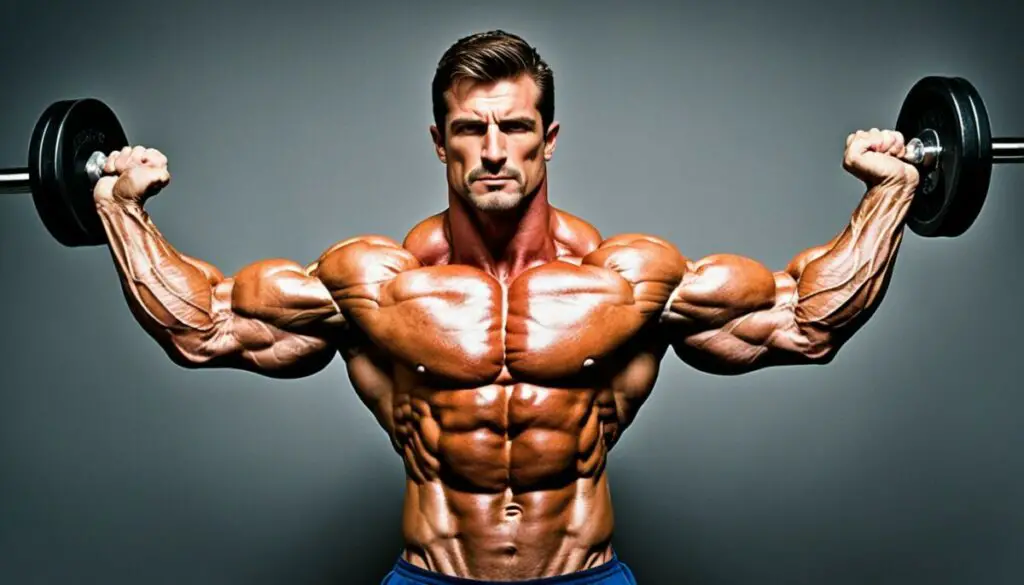Last Updated on 3 months by Francis
Barbell arm curls are a highly effective exercise for maximizing biceps growth and strength. They are often overlooked in favor of other curl variations, but incorporating barbell curls into your routine can help you achieve the bigger, stronger, and more defined arms you desire.
In this article, we will explore the proper technique for barbell arm curls, discuss the benefits and variations of this exercise, and provide valuable tips on how to optimize your biceps workouts with targeted strength training using the barbell.
Contents
Key Takeaways:
- Barbell arm curls are an effective exercise for maximizing biceps growth and strength.
- Incorporating barbell curls into your routine can help you achieve bigger, stronger, and more defined arms.
- Proper form and technique are crucial for maximizing the benefits of barbell arm curls.
- There are variations of barbell curls that can target different areas of the biceps.
- Strength training with barbell curls can provide a targeted workout for your biceps.
Understanding Barbell Curls and Their Purpose

Barbell curls are a type of bicep curl exercise that uses a straight barbell to target the biceps muscles. These strength-building exercises are an essential component of any biceps strength training routine and can be incorporated into your workout for optimal results.
When performing barbell curls, the primary focus is on building strength in the biceps muscles. However, they also contribute to biceps growth, helping you achieve bigger and more defined arms.
By understanding the purpose of barbell curls, you can effectively incorporate them into your arm workouts and maximize their benefits. Whether you’re a beginner or an experienced lifter, barbell curls are an excellent addition to your strength training regimen.
“Barbell curls provide a challenging and effective way to target the biceps muscles and build upper body strength.”
Different Variations of Barbell Curls
There are several variations of barbell curls that you can incorporate into your workout routine to add variety and target different areas of the biceps. These variations include:
- Wide-grip barbell curls: This variation involves gripping the barbell with a wider grip, targeting the outer part of the biceps.
- Narrow-grip barbell curls: In this variation, you grip the barbell with a narrower grip, emphasizing the inner part of the biceps.
- Preacher barbell curls: This variation is performed on a preacher bench, which isolates the biceps muscles and reduces the involvement of other muscle groups.
Experimenting with these variations can help you target different areas of the biceps and add variety to your strength training routine.
| Benefits of Barbell Curls | Incorporating Barbell Curls into Your Workout |
|---|---|
|
|
The Difference Between Barbell Curls and Dumbbell Curls

When it comes to targeting your biceps, both barbell curls and dumbbell curls are highly effective exercises. However, there are important differences between the two that can impact your muscle development and overall workout results.
Dumbbell curls work each arm independently, allowing for a greater focus on muscle isolation and promoting balanced muscle development. With dumbbells, you have the freedom to adjust your hand positioning and range of motion, which can enhance overall muscle engagement and control during the exercise. This can contribute to a more symmetrical and aesthetically pleasing bicep development.
On the other hand, barbell curls allow you to lift a heavier total weight, making them an effective choice for developing biceps strength. The fixed grip of the barbell also promotes greater stability, which can be beneficial for individuals who struggle with maintaining proper form during dumbbell curls. Additionally, the barbell curl allows for a more controlled movement, minimizing the risk of swinging or cheating to lift the weight.
To achieve balanced muscle development and maximize your biceps workout, it is recommended to incorporate both barbell curls and dumbbell curls into your routine. This will provide a well-rounded approach that targets different muscle fibers and allows for variety in training stimulus.
The Benefits of Barbell Curls
Barbell curls offer several unique benefits that can enhance your biceps training:
- Increased Total Weight Lifted: With a fixed grip, you can lift heavier weights compared to dumbbell curls. This can lead to greater muscle strength and overall hypertrophy.
- Efficiency and Time-Saving: As a compound exercise, barbell curls engage multiple muscle groups, including the biceps, forearms, and even the core. This can help you make the most of your workout time and achieve results more efficiently.
- Stability and Control: The fixed grip and bar path of barbell curls promote stability and precise control of the weight, minimizing the risk of injury and maximizing muscle engagement.
By incorporating both barbell curls and dumbbell curls into your routine, you can achieve a balanced and comprehensive approach to biceps training. This combination allows for targeted muscle development, total weight lifting progression, and overall strength building.
When and How Often to Do Barbell Curls

Timing and frequency are key factors when incorporating barbell curls into your biceps workout schedule. By understanding when and how often to perform this exercise, you can maximize its effectiveness and avoid overtraining.
Timing of Barbell Curls
Barbell curls can be performed at any time during an arm workout. However, if you are including them in a session that involves other body parts, it is recommended to do them towards the end. This ensures that your biceps are sufficiently warmed up and ready to handle the weight, allowing you to maintain proper form and engage the targeted muscles effectively.
Frequency of Barbell Curls
When it comes to the frequency of barbell curls, it’s important to strike a balance. Training your arms two or three times a week is sufficient to stimulate growth and strength development in the biceps. However, it’s crucial to mix up your exercise selection and not perform barbell curls more than once a week.
Overtraining the biceps by excessively performing barbell curls can lead to decreased performance, muscle fatigue, and even injury. By incorporating a variety of biceps exercises and focusing on overall arm development, you can ensure a well-rounded and effective biceps workout schedule.
Remember, quality over quantity is key when it comes to building stronger and more defined biceps. Listen to your body, adjust the frequency based on your fitness level and recovery ability, and always prioritize proper form and technique.
Proper Form for Barbell Curls

To perform barbell curls with proper form, follow these steps:
- Starting Position: Grip the barbell with your hands slightly wider than shoulder-width apart. Stand with your feet shoulder-width apart, maintaining a straight posture.
- Execution: Start with the bar against the front of your thighs, arms fully extended and straight. Keep your upper arms stationary and your elbows tight against your sides throughout the exercise.
- Range of Motion: In a controlled manner, curl the barbell up towards your shoulders, focusing on contracting your biceps. Keep your wrists straight and avoid any swinging or momentum. Aim to bring the barbell up to shoulder height.
- Top Position: Once you have reached the top of the contraction, squeeze your biceps for a brief moment. This maximizes muscle activation and helps optimize your results.
- Lowering the Barbell: Slowly lower the barbell back down to the starting position, fully extending your arms. Maintain strict form and control the movement throughout the entire range of motion.
Remember, the key to proper barbell curls is maintaining strict form and executing the movement with control. By following these steps, you can effectively target your biceps and maximize the benefits of this exercise.
“Proper form is crucial for getting the most out of your barbell curls. Keep your upper arms stationary, elbows tight, and focus on a full range of motion to effectively target your biceps.” – Fitness Trainer
Tips for Improving Barbell Curl Performance

Improving your barbell curl performance can help you squeeze the most out of your biceps workout. Here are some tips to help you maximize your gains:
Squeeze the Barbell:
When performing barbell curls, focus on squeezing the barbell tightly during each repetition. This will help recruit more muscle fibers in your biceps, leading to better muscle activation and growth.
Superset with Dumbbell Exercises:
Supersetting barbell curls with dumbbell exercises can be a great way to accelerate progress. By alternating between the two exercises, you can challenge your muscles in different ways and stimulate greater muscle growth.
Minimize Upper Body Movement:
To fully engage your biceps muscles during barbell curls, it’s important to minimize upper body movement. Avoid using momentum or swinging your body to lift the weight. Instead, focus on controlling the movement and isolating the biceps.
Maximize Range of Motion:
Achieving a full range of motion is crucial for maximizing the effectiveness of barbell curls. When performing each repetition, aim to go as far as possible at the top by fully contracting your biceps. Likewise, fully straighten your arms at the bottom of the movement to stretch the muscles and enhance muscle activation.
By implementing these tips into your barbell curl routine, you can improve your performance, enhance muscle growth, and take your biceps workout to the next level.
Alternative Exercises to Barbell Curls
If you experience wrist or elbow pain during barbell curls, there are alternative exercises you can try. These alternatives provide wrist and elbow-friendly options that target the biceps effectively.
EZ-biceps bar curl
The EZ-biceps bar curl is a great alternative to barbell curls for individuals with wrist or elbow pain. This exercise places less stress on the joints, allowing you to perform the movement with reduced discomfort. To perform the EZ-biceps bar curl, simply grip the EZ-bar with an underhand grip and curl it up towards your shoulders. Maintain proper form and focus on engaging your biceps throughout the exercise.
Drag biceps curl
The drag biceps curl is another excellent alternative that helps target the biceps while minimizing strain on the wrists and elbows. To perform this exercise, start by gripping the barbell with an underhand grip. As you curl the weight up, focus on dragging it up your body, keeping it close to your torso. This dragging motion enables greater biceps activation and can be a more wrist and elbow-friendly option compared to traditional barbell curls.
It is important to find the alternative exercise that works best for you and allows you to perform the movement pain-free. Experiment with different variations and listen to your body to determine which option suits you the most. By incorporating these wrist and elbow-friendly alternatives, you can continue to target your biceps effectively without compromising your joint health.
| Exercise | Description |
|---|---|
| EZ-biceps bar curl | An alternative to barbell curls that places less stress on the wrists and elbows. Gripping the EZ-bar with an underhand grip, curl it up towards the shoulders while maintaining proper form. |
| Drag biceps curl | A biceps curl variation that involves dragging the barbell up the body as you curl, targeting the biceps more effectively. This exercise can be a wrist and elbow-friendly option. |
The Essentials for Building Bigger Biceps
When it comes to building bigger biceps, there are a few essential factors to consider. By focusing on these key elements, you can optimize your biceps workouts for maximum muscle growth and strength.
1. Muscle Isolation
One of the essential aspects of biceps training is isolating the target muscles. To maximize biceps growth, it’s important to perform exercises that specifically target and engage the biceps. By focusing on proper form and technique, you can ensure that the biceps are effectively activated during each repetition.
2. Overloading the Muscles
To stimulate muscle growth, it’s crucial to progressively overload the biceps with increased volume and intensity. This can be achieved by gradually increasing the weight lifted, performing more repetitions, or incorporating various training techniques such as drop sets or supersets. By pushing your muscles outside their comfort zone, you create the stimulus necessary for growth.
3. Achieving a Pump
One of the goals of a biceps workout is to achieve a pump. This occurs when blood rushes into the muscles, providing them with vital nutrients and enhancing muscle growth. Tension-based exercises, such as bicep curls, can help create this pump effect. By focusing on controlled movements and squeezing the biceps at the peak of each contraction, you can maximize muscle pump and stimulate growth.
4. Effective Positioning
The positioning of your hands and elbows during biceps exercises can impact the muscle fibers that are targeted. By adjusting your grip width and elbow positioning, you can engage different parts of the biceps, promoting balanced muscle development and overall growth. Experiment with various hand positions and elbow angles to find what works best for you.
By incorporating these essential elements into your biceps workouts, you can optimize muscle growth and strength. Remember to prioritize muscle isolation, progressively overload your muscles, aim for a pump, and experiment with effective positioning. With consistent training and proper technique, you’ll be on your way to building bigger and stronger biceps.
Proper Execution of Barbell Biceps Curls
Now that you have mastered the basics of biceps training with other curl variations, it is time to incorporate barbell curls into your routine. Barbell biceps curls are an essential exercise for targeting the biceps muscles and maximizing their growth. To ensure optimal results, it is crucial to execute this exercise properly.
Technique for Barbell Biceps Curls
When performing barbell biceps curls, focus on the following technique:
- Stand with your feet shoulder-width apart and keep your back straight.
- Grip the barbell with an underhand grip, hands slightly wider than shoulder-width apart.
- Start with the bar resting against the front of your thighs, arms fully extended.
- Keep your elbows close to your sides and avoid any swinging or jerking motions.
- Engage your biceps muscles and exhale as you curl the barbell upward, contracting your biceps at the top of the movement.
- Inhale as you lower the barbell back to the starting position, ensuring a controlled descent without swinging.
By maintaining good form throughout the exercise, you will effectively target and isolate your biceps muscles, maximizing their growth potential. Focus on the mind-muscle connection and concentrate on the contraction of the biceps muscles during the curling motion.
Muscle Isolation and Adding Load
Barbell biceps curls allow for greater load addition, making them ideal for progressive overload to stimulate muscle growth. As you become more comfortable with the exercise, gradually increase the weight or volume to continue challenging your biceps muscles.
Remember to prioritize muscle isolation and engage only the biceps muscles during the movement. Avoid using momentum or assistance from other muscle groups to lift the barbell. This will ensure that your biceps muscles are effectively targeted and receive the full benefit of the exercise.
Utilizing Supination Force
Supination force refers to the action of rotating your wrists outward as you perform barbell biceps curls, with your palms facing upward during the curling motion. This supination action activates the biceps muscles more effectively and enhances their engagement.
Grip the bar tightly and consciously rotate your wrists outward, maintaining supination throughout the movement. This will maximize the activation of your biceps muscles and further stimulate their growth.
By incorporating proper execution techniques such as maintaining good form, adding load progressively, and utilizing supination force, you can maximize the effectiveness of barbell biceps curls for optimal biceps growth. Now, let’s explore the common mistakes to avoid during this exercise to ensure you achieve the best results.
Common Mistakes to Avoid During Barbell Biceps Curls
While performing barbell biceps curls, it is crucial to avoid common mistakes that can hinder your progress and lead to suboptimal results. By maintaining proper form, avoiding leaning too much, and preventing elbow shifting, you can effectively engage your biceps muscles and maximize the effectiveness of this exercise.
- Maintaining Proper Form: One of the most important aspects of barbell biceps curls is maintaining proper form throughout the exercise. This includes keeping your back straight, shoulders relaxed, and core engaged. Avoid excessive swinging or using momentum to lift the weight, as this can shift the focus away from your biceps and reduce the effectiveness of the exercise.
- Avoiding Leaning Too Much: Leaning too much during barbell biceps curls can put excessive strain on your lower back and decrease the engagement of your biceps muscles. To avoid this, stand tall with your feet shoulder-width apart, maintaining a stable and balanced position throughout the exercise.
- Preventing Elbow Shifting: Elbow shifting is a common mistake that occurs when the elbows move forward, away from the sides of the body, during the curling motion. This can transfer the workload to other muscle groups and reduce the activation of the biceps. To prevent elbow shifting, keep your elbows close to your sides throughout the entire range of motion, focusing on contracting your biceps to lift the weight.
By maintaining proper form, avoiding excessive leaning, and preventing elbow shifting, you can ensure that barbell biceps curls effectively target your biceps muscles and promote growth and strength. Remember to start with a weight that allows you to perform the exercise with proper form and gradually increase the resistance as you gain strength and confidence in your technique.
Barbell Biceps Curls: Who Should Do Them and When
Barbell biceps curls are a classic and effective exercise for building impressive biceps, but they may not be suitable for beginners or those new to biceps training techniques. It’s important to develop proper form and muscle engagement before incorporating barbell curls into your routine.
For beginners, alternatives such as dumbbell curls or EZ-bar curls are recommended. These exercises allow for better control and isolation of the biceps muscles, helping beginners develop the necessary foundation for more advanced movements. By mastering proper form and muscle activation with these alternatives, beginners can gradually progress to barbell curls.
Once you have attained the fundamental skills and strength required for barbell curls, you can incorporate them into your workouts to add more load and maximize biceps growth. Barbell curls allow for heavier weights to be lifted, leading to increased muscle stimulation and strength development.
In summary, barbell biceps curls are best suited for those who have mastered the basics of biceps training and are ready to progress to more challenging exercises. Beginners should focus on alternatives and gradually work their way up to barbell curls to ensure proper technique and muscle engagement.
Conclusion
Incorporating barbell arm curls into your biceps workouts is a proven strategy for optimizing biceps growth and strength. By mastering the proper technique and form, you can maximize the benefits of this versatile exercise.
Barbell arm curls offer a range of advantages, including the ability to target multiple muscles in the biceps, enabling you to build bigger, stronger, and more defined arms. They allow for progressive overload, enabling you to continually challenge your muscles and stimulate growth.
When incorporating barbell arm curls into your routine, it’s important to start with an appropriate weight and gradually increase it to avoid injury. Focus on maintaining proper form throughout each repetition, engaging your biceps fully and minimizing the involvement of other muscle groups.
So, whether you’re a beginner or a seasoned lifter, don’t underestimate the power of barbell arm curls in optimizing your biceps workouts. Add them to your training routine and watch your biceps grow and develop into the impressive arms you’ve always wanted.
FAQ
What muscles do barbell arm curls target?
Barbell arm curls primarily focus on building strength in the biceps muscles.
How do barbell curls differ from dumbbell curls?
Barbell curls allow you to lift a heavier total weight, while dumbbell curls work each arm more evenly for balanced muscle development.
When should I do barbell curls during my workout?
Barbell curls can be performed at any time during your arm workout, but it is recommended to do them towards the end if incorporating them with other body parts.
How often should I do barbell curls?
Training your arms two or three times a week is sufficient, but it is important to avoid overtraining by not performing barbell curls more than once a week.
What is the proper form for barbell curls?
Grip the barbell slightly wider than shoulder-width apart, keep your upper arms stationary and elbows tight against your sides, curl the bar up to shoulder height, squeeze your biceps at the top, and slowly lower the bar back down.
How can I improve my barbell curl performance?
Focus on squeezing the barbell tightly, superset with dumbbell exercises, minimize upper body movement, and maximize your range of motion during each repetition.
Are there alternative exercises to barbell curls?
Yes, alternatives such as the EZ-biceps bar curl and the drag biceps curl can be effective and less stressful on the joints.
What are the essentials for building bigger biceps?
The essentials include isolating the biceps muscles, overloading the muscles with increased volume, creating a pump through tension-based exercises, and positioning your hands and elbows to engage different parts of the biceps.
How do I properly execute barbell biceps curls?
Proper execution involves isolating the biceps muscles, overloading the muscles by increasing the weight or volume, and utilizing supination force by gripping the bar tightly.
What common mistakes should I avoid during barbell biceps curls?
Avoiding maintaining proper form, excessive leaning or arching of the back, and shifting of the elbows forward.
Who should do barbell biceps curls and when?
Barbell biceps curls are suitable for individuals who have mastered proper biceps training techniques. Beginners should start with alternatives such as dumbbell curls and EZ-bar curls to develop proper form and muscle engagement before incorporating barbell curls.
What are the benefits of barbell curls for biceps growth?
Barbell curls are a valuable exercise for maximizing biceps growth and strength.








